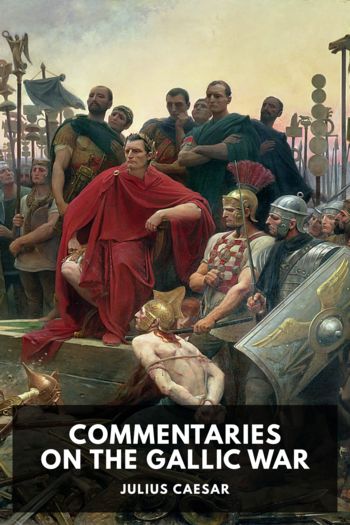Fateful Lightning: A New History of the Civil War & Reconstruction by Allen Guelzo (icecream ebook reader txt) 📗

- Author: Allen Guelzo
Book online «Fateful Lightning: A New History of the Civil War & Reconstruction by Allen Guelzo (icecream ebook reader txt) 📗». Author Allen Guelzo
They were, of course, fooling themselves, and Russell knew it. No people who wanted to be ruled by aristocrats ever defended states’ rights with the doggedness that Southerners demonstrated: “Nothing like it has been heard before, and no such Confederation of sovereign states has ever existed in any country in the world.” The Prussian-born Francis Lieber, who taught at South Carolina College in the 1840s and 1850s and who knew an aristocrat when he saw one, thought that the great planters “are arrogant indeed but not aristocrats.” They were, in truth, something even more peculiar.45
It was not only the South’s mysterious preoccupation with cotton agriculture that seemed to foreign observers to have shaped a culture of Romantic conservatism. It was the particular form of labor that the South used in cotton agriculture—slaves—that seemed to set the region off, not only from the North but also from the rest of the nineteenth century. Western Europeans had kept slaves ever since the end of the Roman Empire, and even in the heyday of classical Greece and Rome, slavery had been an everyday feature of urban and rural life. The reason for this was simple: in ages that knew only the most basic forms of labor-saving machinery, slaves provided a docile workforce that did not require an equal share of one’s wealth or success. Yet slavery was not always successful and slaves were not always docile, and over the course of the Middle Ages the institution of slavery was gradually narrowed to serfdom, which slowly yielded to simple renter, or tenant, status.46
Still, slavery did not disappear entirely. Western Christianity, although it gave little reason to encourage slavery, did not forbid it, either. The rediscovery of ancient Greek and Roman literature in the Renaissance further reminded western Europeans that slavery had once been an important part of great societies that European humanists admired. Above all, the decimation of European society that resulted from the waves of lethal epidemics and national warfare in the fourteenth century created a revived need for cheap labor, and slave labor was the easiest way to fill that bill. By the end of the 1400s, one-tenth of the population in the Portuguese seafaring capital, Lisbon, was in some form of slavery. Over the next 400 years, as Europeans began pushing outward to the Indies and the New World, the demand for enslaved labor kept pace. More than 10 million Africans were snatched from the West African coastal regions, from Senegal to Angola, and shipped as slave labor to the New World; close to half a million of these victims were shipped to North America, with more than half of those sucked directly to the Southern ports of Charleston and Savannah.47
Slavery in the American South appeared, at first glance, to be simply a continuation of the slavery people knew from the Bible or from Caesar, Livy, or Suetonius. But in many respects, Southern slavery, like the other forms of New World slavery from Columbus onward, was a very different affair from what Europeans had known in ancient times. Like ancient slavery, Southern slavery had been called into being by economic circumstances—in colonial Virginia, by the need for a cheap labor force to harvest tobacco, a crop that became profitable only when harvested in greater volume than one tobacco farmer could undertake. In the New World case, however, there was a significant difference from all the other forms of slavery that Western civilization had known. This time, slavery was based on race.
Although colonial Southerners searched for cheap sources of labor in white indentured servants, redemptioners, Indians, and prisoners of war, almost all of these forms of forced labor had time limits and legal obligations attached to them, and fugitives could easily blend into the white or Indian population without much fear of being identified and tracked down. While those limitations eventually forced these practices out of existence, before the end of the 1600s Southern white colonists had found a permanent solution to their labor problems by opening their ports and plantations to the thriving transatlantic African slave trade. African slave labor turned out to be easily transferable to Chesapeake tobacco growing. Using captured Africans as slaves paid additional dividends to colonial slaveholders: their complexion marked them off as a different race of beings to European eyes, so fugitives could be more easily identified and recaptured. Because their owners saw all people of African descent as a coherent group—black—their labor could be bounded with an entirely different set of assumptions than would prevail for white labor. This lent the twist of race to Southern slavery, making what had ordinarily been a matter of economic exploitation into a system of racial exploitation as well. 48
Colonial slavery was also a far more brutal and ruthless system of labor organization than the slaveries of the dim past. American slavery involved from the start the kidnapping of other human beings from their homes, subjecting them to the horrors of transportation across the Atlantic Ocean in fetid and disease-ridden slave ships, where as many as half died en route, and then selling them like cattle; slaves had no real hope of ever obtaining their freedom again. This kind of brutality toward other human beings, which departed dramatically from anything Protestant Americans could read concerning slavery in their Bibles, could not be justified in an avowedly Christian society—unless, of course, it could be shown that the slaves were not really human beings at all.49
It was here that the Romantics served yet another purpose. Taking de Maistre one step further, Arthur de





Comments (0)